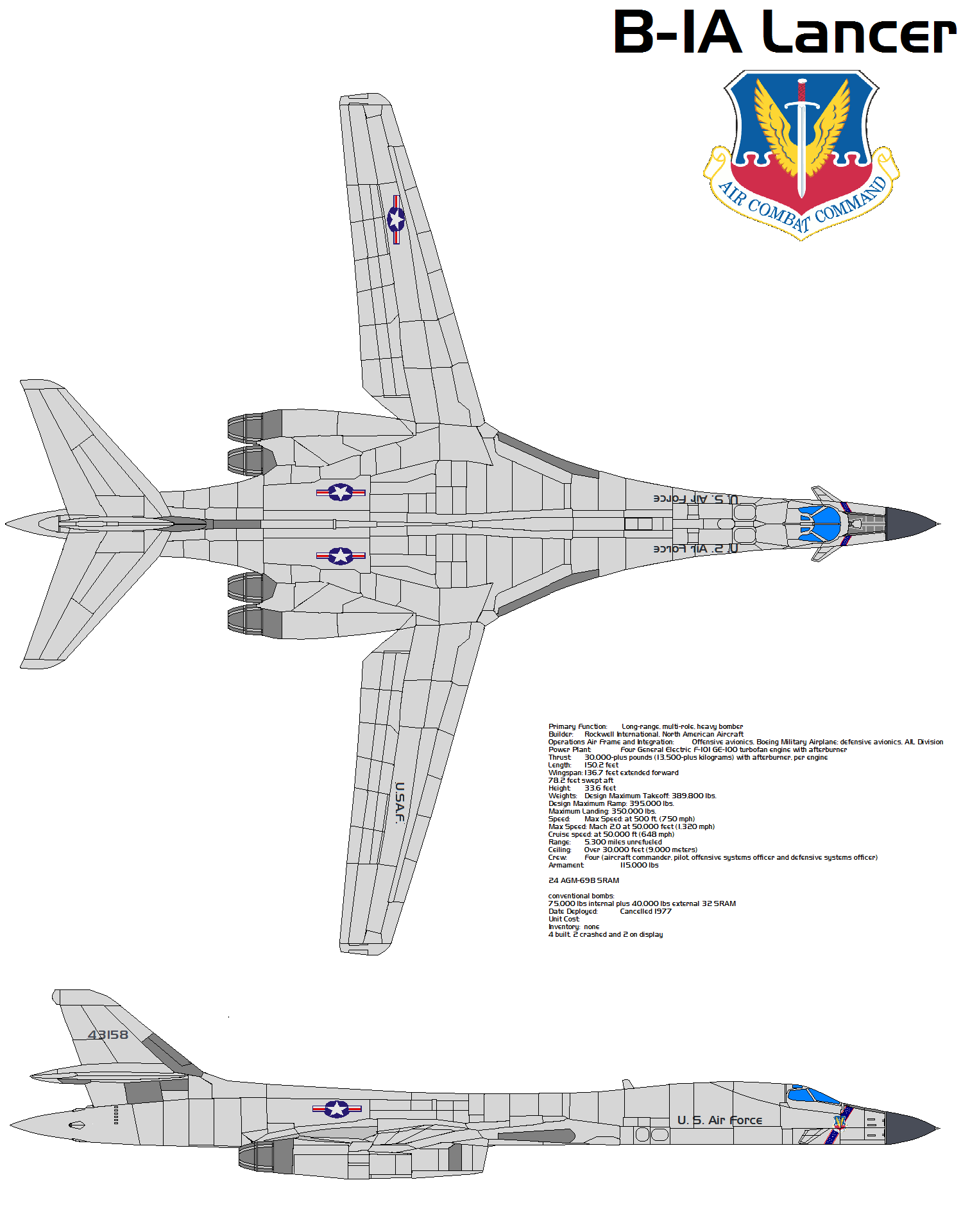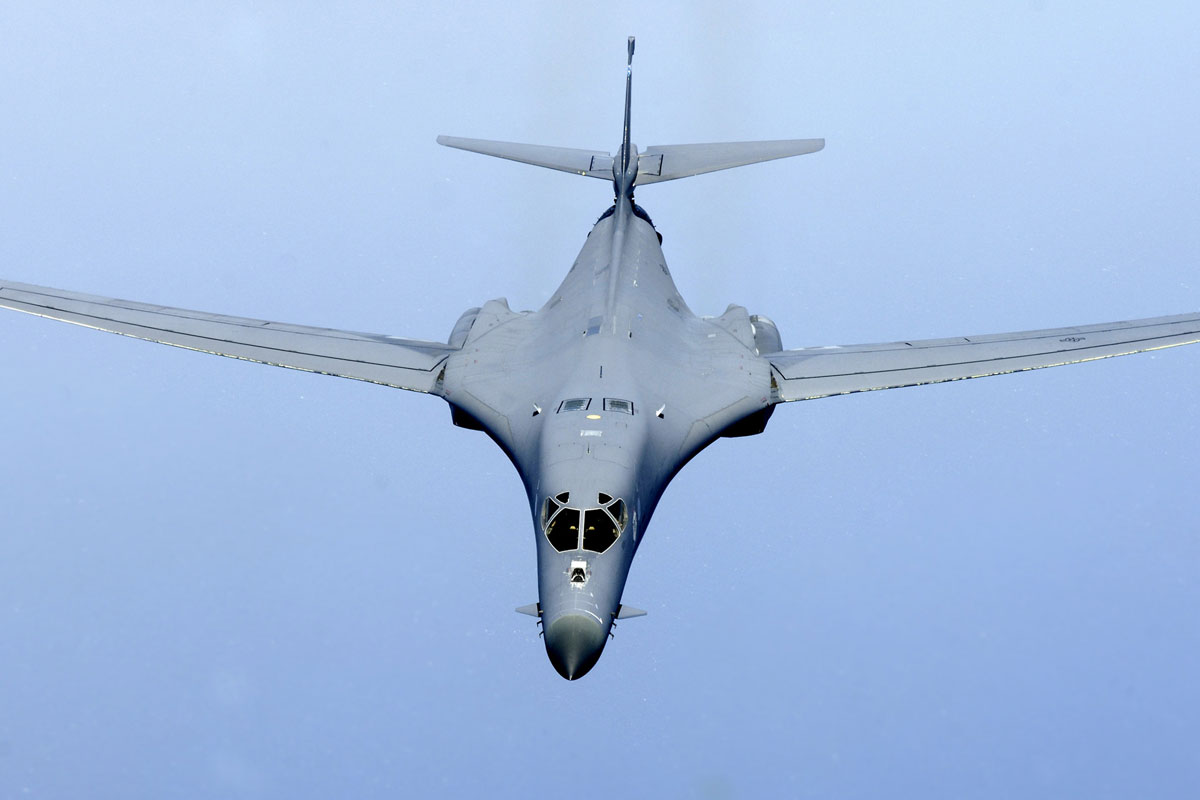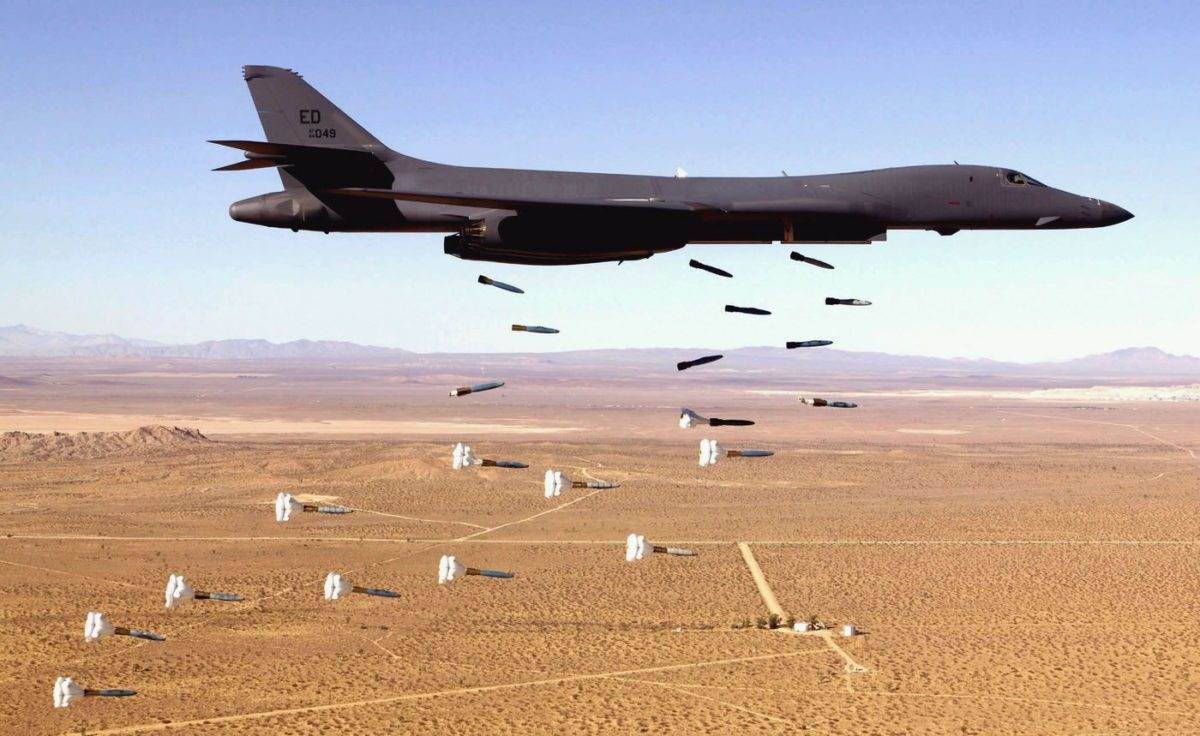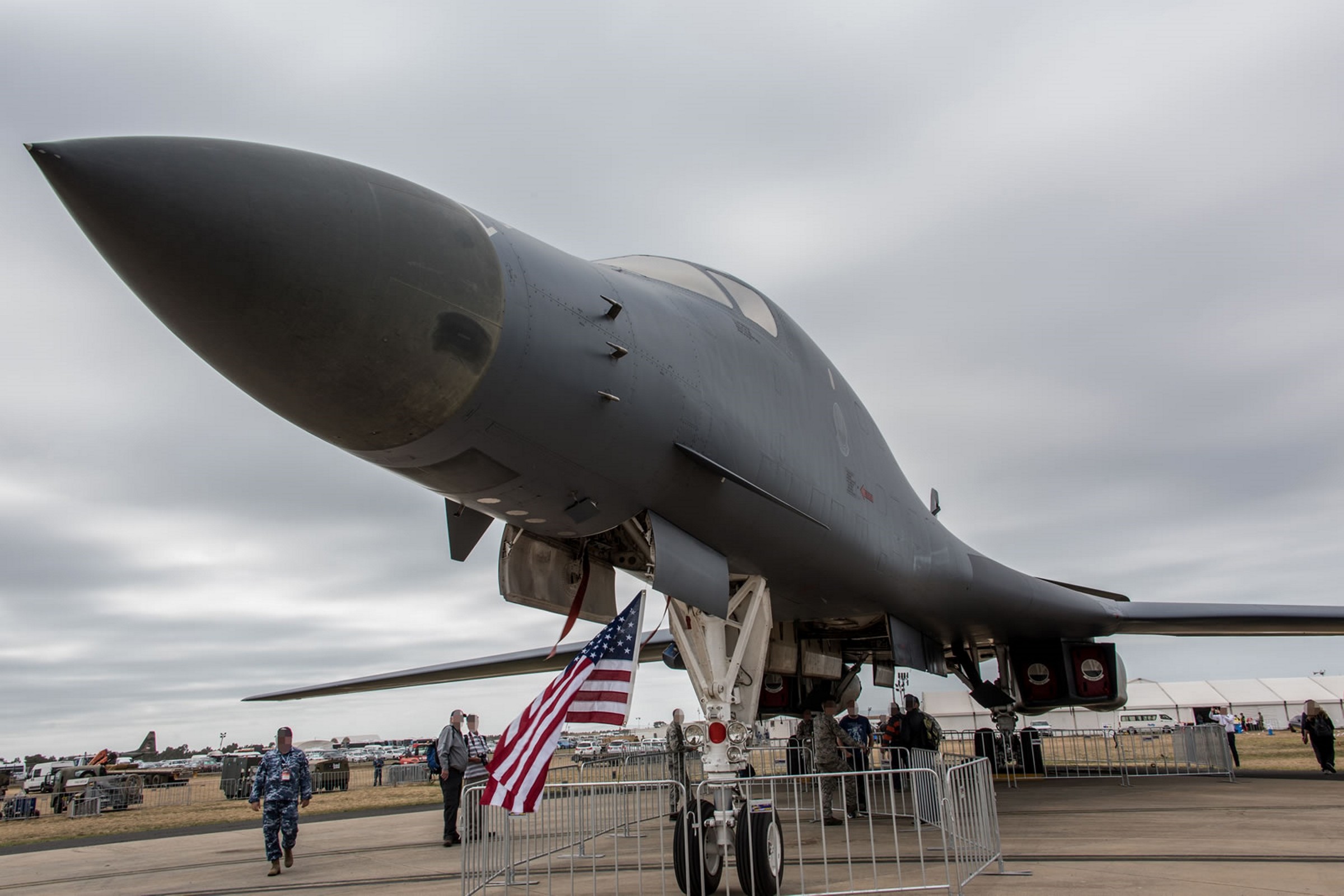B-1 Lancer Cost - An advanced variable wing used by the United States Air Force. Commonly referred to as "Bone" (from "B-One").
It is one of three strategic bombers in the US Air Force fleet by 2022, along with the B-2 Spirit and B-52 Stratofortress.
B-1 Lancer Cost

The B-1 was first conceived in the 1960s as a platform that would combine the Mach 2 speed of the B-58 Hustler with the range and payload of the B-52, and was intended to eventually replace both the bomber. After extensive research, Rockwell International (now part of Boeing) won the design competition for what emerged as the B-1A. This version had a top speed of Mach 2.2 at high altitude and long-range flight at Mach 0.85 at very low altitude. The combination of the aircraft's high cost, the introduction of the AGM-86 cruise missile with the same basic speed and range, and work on the B-2 stealth bomber reduced the need for the B-1. The program was terminated in 1977 after the B-1A prototypes were built.
B 1s Can Make It To Finish Line, But Big Repairs Will Be Common Along The Way
The program was restarted in 1981 as a temporary measure, largely due to delays in the B-2 stealth bomber program. The B-1A's design was modified, reducing its top speed to Mach 1.25 and increasing its low altitude speed to Mach 0.96, greatly improving its electronic components and upgrading its airframe to carry more fuel and weapons. A new variant known as the B-1B was released in 1986; The aircraft entered official service with the Strategic Air Command (SAC) that year as a nuclear bomber. By 1988, all 100 aircraft had been delivered.
With the creation of SAC and the redesignation of Air Combat Command in 1992, the B-1B transitioned to a conventional bomber role. It first took part in Operation Desert Fox in 1998 and again the following year in NATO's war in Kosovo. The B-1B supported US and NATO forces in Afghanistan and Iraq. By 2021, the Air Force has 45 B-1Bs.
The Northrop Grumman B-21 Raider will replace the B-1B after 2025; all B-1 aircraft are scheduled to be retired by 2036.
In 1955, the USAF issued requirements for a new bomber that combined the payload and range of the Boeing B-52 Stratofortress with the Mach 2 top speed of the Convair B-58 Hustler.
Us Bombers Fly Near Korean Peninsula
In December 1957, the US Air Force selected the North American Air Force's B-70 Valkyrie for this role, a six-engine bomber capable of a Mach 3 cruise speed at high altitude (70,000,000 ft or 21,000 m).
The Valkyrie is expected to fly at similar altitudes but at higher speeds and is expected to be a direct flight from fighter jets.
The XB-70 Valkyrie replaced the Hustler in 1957, but suffered as a result of the doctrinal shift from a high-altitude flight profile to a low-altitude flight profile.

The USAF Strategic Air Command (SAC) was aware of this development and began moving its bombers to low-level targets prior to the U-2 launch. This tactic will greatly reduce radar detection range by using ground masks; By taking advantage of terrain features such as hills and valleys, it can be linear from the radar to the bombardment, invisible to the radar (and human observers).
B 1b Lancer
In addition, radars of the era were subject to "blurring" by ground and other objects, meaning there was a minimum angle above the horizon at which a target could be detected. Low-altitude bombers can stay at these angles, maintaining distance from radar targets. The combination of these effects made air defense systems of the time ineffective against low-flying aircraft.
The same effects mean that low-flying aircraft are difficult to detect from higher-flying interfaces, as radar systems cannot easily pick out aircraft against ground ray blur (lack of track/shoot capability).
The transition from a high-altitude flight profile to a low-altitude flight profile severely affected the B-70, which was designed for high altitude. The higher aerodynamic drag at low altitude greatly reduced its range and limited the B-70 to subsonic speeds.
The result would be an aircraft slightly better than the B-52, but with a shorter range. Because of this and the growing intercontinental ballistic missile (ICBM) capability, the B-70 bomber program was canceled in 1961 by President John F. Kennedy.
B 1b: Still Bad To The B One
Although it was never intended for a low-level role, the B-52's versatility allowed it to develop its indigenous successor as the nature of the fighter air war changed. The B-52's larger fuel load allows it to operate at lower altitudes for longer periods of time, and its larger airfield allows it to incorporate improved radar suppression and radar-trigger decoy systems.
During the Vietnam War, the idea that all future warfare would be nuclear became a reality, and "big belly" modifications increased the B-52's total bomb load to 60,000 pounds (27,000 kg).
Making it a powerful tactical aircraft that can be used against ground forces as well as strategic targets from high altitudes.

A smaller bomb bay than the B-70 would be less useful in this role.
America's B 1b Bomber Fleet Was Just Massively Updated
Although effective, the B-52 was not ideal for the low-level role. This led to several designs of aircraft, called petrators, specially designed for long-distance, low-altitude flight. The first of these designs was the advanced F-111 fighter, which used variable sweep wings for tactical missions.
The first strategic development after the B-70 was called the Subsonic Low-Altitude Bomber (SLAB), completed in 1961. This resulted in a design that looked more like an airplane than a bomber, with a big T-wing—a big, high-spinning demon.
This was followed by similar Extended Range Aircraft (ERSA) in the aviation industry that added a variable sweep wing. ERSA observed the small aircraft at 2,900 miles (4,700 km), flying at low altitudes with a payload of 10,000 pounds (4,500 kg) and a range of 10,070 miles (16,210 km). In August 1963, a design for a similar low-altitude controller, the Petrator, was completed, requiring an aircraft with a 20,000 lb (9,100 kg) bomb load and a slightly shorter range of 8,230 mi (13,240 km). .
It all culminated in October 1963 with the Advanced Manned Precision Strike System (AMPSS), which led to industrial research by Boeing, General Dynamics and North America.
A Single B 1b Lancer Can Deliver The Same Punch As A Dozen F 16s And Deliver It At A Fraction Of The Cost. When It Comes To Cost Per Effect Benefits, The Bomber
In mid-1964, the US Air Force revised its requirements and renamed the project the Advanced Manned Strategic Aircraft (AMSA), which differed from the AMPSS mainly because it required a higher speed and higher altitude than the existing Mach. Class 2 F-111.
Rockwell, the creators of the latest round of design studies, said the new name is truly "America's most studied airplane."
The controversy that led to the cancellation of the B-70 program led some to question the need for a new strategic bomber. The US Air Force is adamant about maintaining bombers as part of a nuclear triad that includes bombers, intercontinental ballistic missiles, and submarine-launched ballistic missiles (SLBMs). They argued that the bomber was needed to attack heavily hit military targets and provide a safe force, as bombers could be dropped quickly into safe areas that could not be attacked. However, the introduction of the SLBM challenged its mobility and survivability, and newer intercontinental ballistic missiles, such as the Minuteman III, lacked the accuracy and speed needed to attack targets. During this period ICBMs were chosen as a cheaper option,

Defense Secretary Robert McNamara prioritized intercontinental ballistic missiles over bombers for the Air Force's deterrence component
Air Show: Us' B 1b Lancer To Undertake 'fly By' At Aero India: What Makes The Long Range Bomber Such A Formidable Threat
McNamara opposed the program to modernize the existing B-52 fleet and add about 300 FB-111s for the short-range roles performed by the B-58.
President Richard Nixon reinstated the AMSA program after taking office, consistent with his administration's flexible response strategy, which called for options other than all-out nuclear war.
Nixon's Secretary of Defense, Melvin Laird, reviewed the programs and decided to reduce the number of FB-111s due to the lack of desired range and recommended that the AMSA design study be expedited.
This was the first attempt at a new series of bomb detonators designed in 1962. The Air Force issued a request for proposals in November 1969.
Usaf Won't Retire More B 1s Until B 21 On Duty
The original program called for two test airfields, five flying aircraft and 40 demons. This was reduced to one seat and three flight test aircraft in 1971.
The company changed its name to Rockwell International and in 1973 renamed its aircraft division North American Aircraft Operations.
The fourth prototype, built to production standards, was ordered in the fiscal year 1976 budget. Plans called for 240 B-1As to be built in 1979 with initial operational capability.

The Rockwell design shares commonalities with the General Dynamics F-111 Aardvark and the North American XB-70 Valkyrie. If the crew had to evacuate the aircraft at high speed, the crew escape pod was used as a compartment to enhance crew survivability. In addition, the design incorporates large variable sweep blades to provide both
The Story Of The B 1 Bomber: From 1964 To Today
Revell 1 48 b 1b lancer, b 1b lancer model, revell b1 b lancer 1 48, b-1 lancer, lancer cost, boeing b 1 lancer, b 1 lancer cockpit, b lancer, rockwell b-1 lancer, b 1b lancer, lancer 1, b 1 lancer bomber

0 Comments